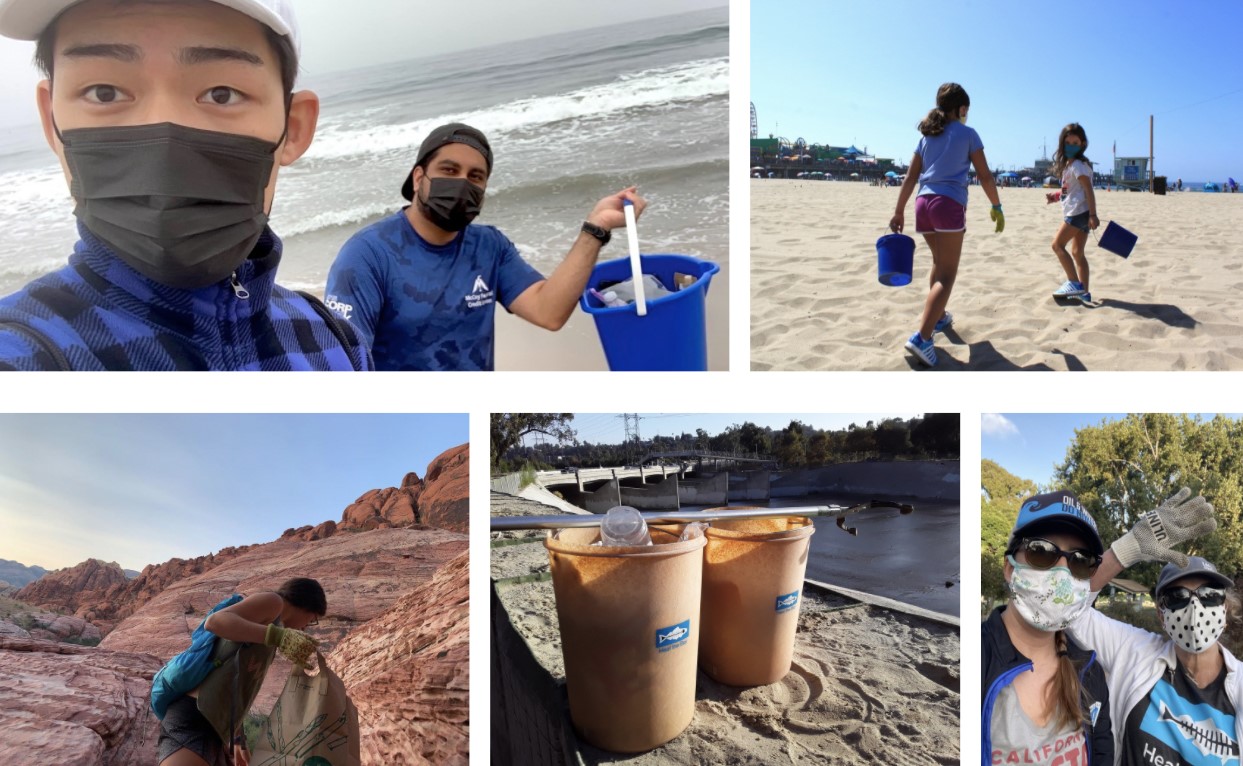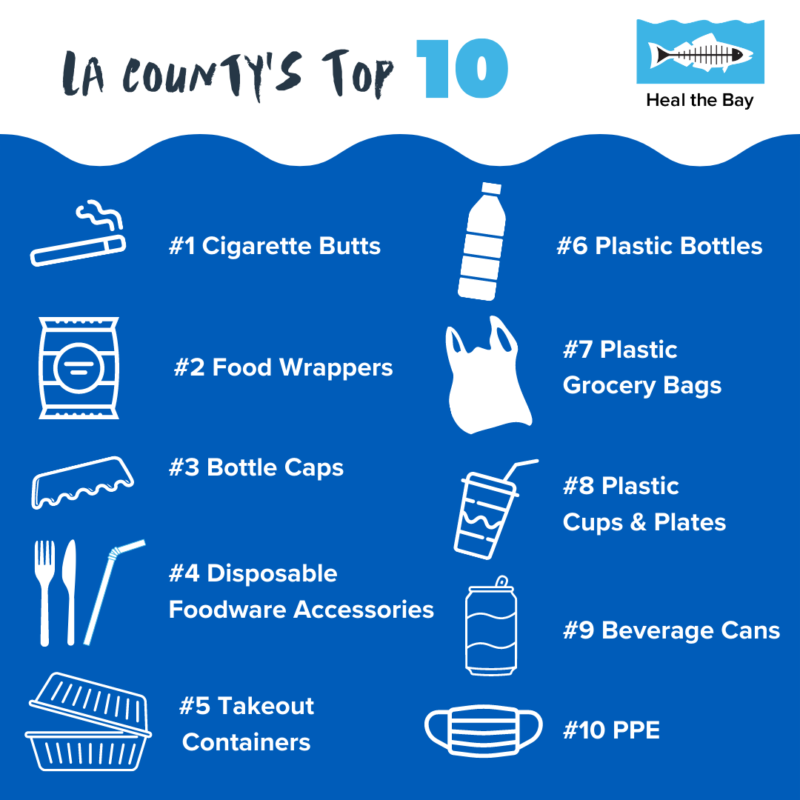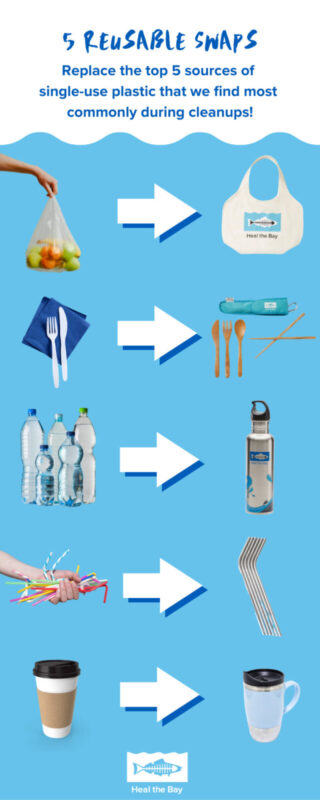From Summit to Sea, Together We Made Coastal Cleanup Month a Huge Success
CaliforniaCalifornia Bag BanCoastal Cleanup DayEventsLos AngelesPlastic PollutionPolystyreneTake Action

As the sun sets on Coastal Cleanup Month, we are looking back with gratitude and appreciation for everyone who participated in a cleanup, helped us spread the word, raised funds, and joined a virtual event over the course of the month. At a time when it’s easy to feel isolated from one another, it is inspiring to see how we came together across the County, from summit to sea, to protect what we love.
A New Take on 2020
Heal the Bay has been the LA County coordinator for Coastal Cleanup Day for more than 30 years, and 2020 proved to be a completely different cleanup effort than years past. In an effort to prioritize the health and safety of the community, the re-imagined concept was expanded to become an entire month of individualized cleanups close to home and virtual programming to educate about the impacts of trash and pollution and how we can work together towards solutions. Our Heal the Bay Aquarium education team engaged 437 LAUSD students with virtual programming about protecting our watersheds. This was also the first year that we asked for volunteer fundraisers to support our clean water mission. Fundraising teams and individuals raised close to $2,000, and we are grateful for their support.
Each week of Coastal Cleanup Month focused on a different region, starting at the top of our mountains, working through our neighborhoods & waterways, and culminating at our wetlands & beaches. The weekly programming featured a series of panels, webinars, and Instagram Lives with partner organizations that explored the various community and environmental issues facing Los Angeles County.
None of this would have been possible without our Coastal Cleanup Month sponsors, and we would like to thank Water for LA, Blue Shield, K-Swiss, Ford, and West Basin Municipal Water District for their support.
2020 Impact
This year, we set a goal of collecting 31,000 pieces of trash throughout the month of September. Thanks to our dedicated Regional Ambassadors and 2,334 registered cleanup volunteers, we surpassed this goal with a total of 40,101 pieces of trash collected!
The top 10 items found across Los Angeles County in the month of September were:

Download our full Coastal Cleanup Month Wrap-Up Book for 2020
The Effects of PPE and the Pandemic on Our Environment
Coastal Cleanup Month was the first initiative of this scale to track the impact of the improper disposal of single-use personal protective equipment (PPE) in LA County. In the first year of tracking this item, PPE was one of the top 10 items found by our volunteers, surpassing common items like glass bottles.
Through our data, we can clearly see the effects of the pandemic on our waste stream. Another observation is that people are relying more than ever on takeout, delivery, and outdoor dining at beaches, parks, and other public spaces. Disposable foodware accessories like utensils, straws, and takeout containers were some of the most common items found during cleanups.
The Plastic Problem
Looking at the data collected throughout Coastal Cleanup Month, it’s obvious that single-use plastic is the top offender. From utensils and straws to takeout containers and grocery bags, our lives are filled with plastic – and so is our environment. Unfortunately, the effects of COVID-19 have worsened these single-use habits and curbed a lot of progress that we’ve seen in Los Angeles over the last several years.
Plastic grocery bags were a common item found during cleanups until California became the first state in the nation to impose a statewide bag ban in 2014. Before the pandemic hit, we were making great strides in reducing our single-use plastic waste. We could bring our reusable bags to the grocery store and refill our reusable coffee cups at Starbucks, and our environment and community were all the better for it. Now, plastic producers are using the pandemic to push disposable plastics as a safer option, a position that has no scientific merit. They were able to undo the work of the state bag ban, and grocery stores statewide have not only reintroduced single-use plastic bags, but many have banned reusable bags from entering stores. This year, we saw plastic grocery bags, cups, and lids in the top 10 items found by our volunteers during Coastal Cleanup Month.
We also found that other than cigarette butts and PPE, the top 10 items are all food and drink-related. With the increasing reliance on takeout and delivery, plastic cutlery and other accessories are becoming a bigger and bigger issue. Restaurants often throw these items in takeout bags regardless of whether the customer needs them or not. To put this in perspective, 40 billion plastic utensils are thrown away each year in the United States. Plastic foodware items, like straws, utensils, and condiment packets cannot be recycled, so they are destined to end up in a landfill, incinerator, or polluting our oceans and communities.
How Can You Help?
Plastic pollution may seem like something that is out of your control. However, there are easy ways you can help make waves of change, from using reusable products when you can to supporting environmental legislation. Here are 3 easy ways to make a change:
- Go reusable!

From grocery bags and utensils to water bottles and coffee cups, there are reusable replacements for almost all single-use plastics. Check out our Heal the Bay Shop for some ideas! If you’re ordering takeout or delivery, make sure to tell the restaurant “no plastic, please!” and use your own utensils instead. Check out Reusable LA and Habits of Waste for easy ways to help combat this issue, like sending an email to third party delivery companies asking them to make plastic cutlery and accessories optional rather than the default. If you’re unsure where to start, conduct a home waste audit to evaluate your daily habits and see where you can replace single-use items with reusables.
- Pack it out.
As a result of limited staff and the increased need to sanitize the bathrooms as a result of COVID-19, Los Angeles County Beaches & Harbors only has the capacity to empty the public trash cans once a day. Combined with the surge of beachgoers picnicking on the sand, this has led to an overwhelming problem of overflowing trash cans and increased beach litter. Similar issues have been observed throughout the County, so if you are enjoying our public spaces, make sure that all trash gets disposed of properly, and pack it out if trash cans are full.
- Use your voice.
Every single person has power! You influence the people close to you by voicing your opinion, you influence companies with the purchases you choose to make, and you can influence policy and legislation with your vote. The California bag ban is a good example of local change leading the charge and turning into statewide change, so don’t underestimate the power of advocating at your local City Council or with the County Board of Supervisors. At its core, plastic pollution is not a consumer problem; it’s a producer problem, and you can use your voice to support plastic policies that make plastic producers responsible for the waste they create.
Get Involved with Heal the Bay
We are excited with the results of Coastal Cleanup Month, but protecting our watersheds and coastline is an everyday effort. There are ways you can continue to stay involved and support our clean water mission year-round with different programs like Adopt-a-Beach, Club Heal the Bay, and MPA Watch. If you’re ready for more action to protect our oceans, join our virtual Volunteer Orientation on October 12. And don’t forget to save the date in September 2021 for next year’s Coastal Cleanup efforts!




